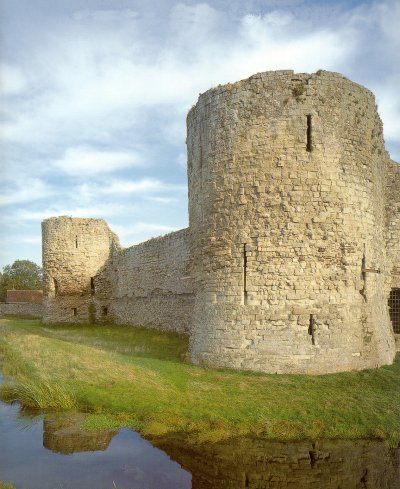Pevensey Castle - the Roman Fort of ANDERITA
|
Of the Roman Saxon-shore forts in Britain, only two, Porchester Castle (Portus Adurni) and Pevensey Castle (Anderidos) or Anderita or Anderida), have survived mainly intact. They have survived because of their use as castles during the medieval period. Of the two, Porchester is visually the most impressive, but Pevensey had the most important role in English history. The following description is based on the one in the English Heritage guide to Pevensey Castle which itself is based on the work of the great Sussex antiquary, the late Dr L F Salzman, who also directed the excavations in the early 1900s. In the latter days of the Roman occupation of Britain, the need to defend the eastern and southern coasts from the attacks of Saxon raiders caused the Roman command to build a series of coastal forts extending from Norfolk to Hampshire. Collectively they are known as Saxon-shore forts, from the title of the officer who commanded the system at least from c. 340 but not from its inception. Most were completed by the 280s. The exception is Pevensey: it alone does not follow the typically Roman quadrilateral, or occasionally pentagonal, plan; its walls are taller than the others and there is sufficient archaeological evidence that it dates from c. 340 and is thus the only 'Saxon-shore fort' that can be confidently stated to have been built for the Saxon-shore command.
According to the Anglo-Saxon Chronicle there was a massacre of Britons by the invading Saxons at Pevensey in 491, but apart from this nothing else is recorded of the history of the fort between the end of the Roman period and the coming of the Normans. In 1066 William of Normandy landed at Pevensey Bay and immediately established himself in the Roman fort. Not long after he took his army to Senlac Hill near Hastings, where he defeated the Saxon King Harold II, in battle. William granted Pevensey to his half-brother Robert, Count of Mortain, who founded a small borough outside the Roman fort and made a castle within it by dividing off a part with a palisaded bank and ditch and repairing the Roman walls. He also built the Great Tower, or keep and the rest of the fort, made to serve as the outer bailey of a Norman castle. In 1088 the castle was held against William Rufus by Robert of Mortain's brother, Odo, Bishop of Bayeux, on behalf of William's elder brother, Robert, Duke of Normandy, and was taken by siege. In 1101 William, Count of Mortain, unsuccessfully rebelled against Henry I, and he forfeited Pevensey. It was granted to Richer de Aquila, or Laigle, in whose family it remained for some time. Gilbert, Earl of Pembroke, held it in Stephen's reign and was there besieged by the King in 1147. On the castle's fall, Stephen then gave Pevensey to his elder son Eustace, and, at his death, to his younger son William, earl of Warrenne.
In 1264-65, the third and most famous siege of Pevensey took place. The supporters of Henry III, fleeing from their defeat by the Barons at Lewes, took refuge in the castle, which was invested by Simon de Montfort the younger. On this occasion the castle stood firm, and the besiegers had eventually to abandon the attempt. It became the custom to grant the Honour of Pevensey to the Queens of England, and in this way Margaret, second wife of Edward I, and Philippa, queen of Edward III, became responsible for appointing Constables of the castle. In 1372 the castle and honour were given to John of Gaunt, whose son Henry, Duke of Lancaster, claimed the crown in 1399, and as a consequence Pevensey had to stand another siege, by the royal troops of Richard II. Sir John Pelham, the constable, had joined the Duke's army, and his wife, Lady Joan Pelham, was left to defend the castle, which she did until relieved. On Henry's accession as Henry IV, Sir John received a grant of the castle and honour, and during his office had to hold such distinguished prisoners as James I, King of the Scots, who had been seized in 1406, and Queen Joan of Navarre, whom her stepson, Henry V, had accused of witchcraft. With the advent of the Tudors the castle ceased to be inhabited, and fell rapidly into decay. In 1587, however, in view of the threat of the Spanish Armada, an earthen gun emplacement was built for two cannon. With the fall of France in 1940 and the imminent threat of German invasion Pevensey Castle suddenly resumed its original military purpose of protecting the British coast. In May 1940 the castle was refortified for use as an observation and command post. Among the troops quartered in it were Canadians, and, in early 1944, the US Army Air Corps, which used it as a radio direction centre. The towers of the medieval castle were fitted out as accommodation; 'pill-boxes' for machine-gun defence were erected on the keep, on certain of the Roman bastions, and among the fallen fragments of the Roman walls; the main southwest entrance of the Roman fort was closed by a blockhouse for anti-tank weapons; and an entirely new tower was added to the eastern wall. These twentieth-century defences were never put to the test, and Pevensey Castle remains untaken by assault. |
For more information and pictures, see Pevensey Castle web-site
Return to Historical Sites Page
 Pevensey Castle walls İEnglish Heritage
Pevensey Castle walls İEnglish Heritage
 Pevensey Roman West Gate- seen here are the two bastions or towers that stood each side of the gate. İEnglish Heritage
Pevensey Roman West Gate- seen here are the two bastions or towers that stood each side of the gate. İEnglish Heritage